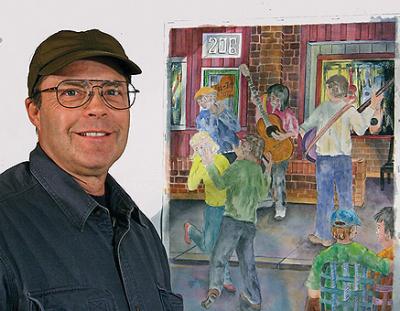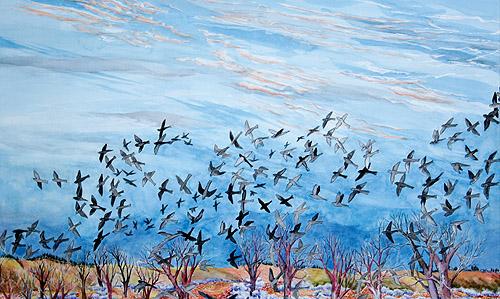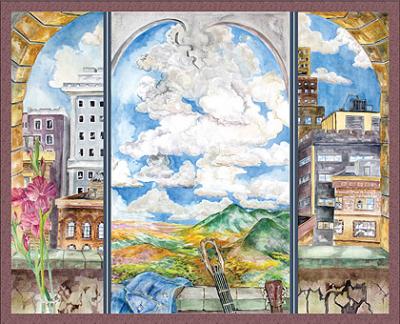Artist Clint Loomis

When a biting easterly wind whips across central Montana, Clint Loomis will say, “Wind’s off the lake.” It’s an odd expression given that the largest body of water around here, Fort Peck Reservoir, is more than one hundred miles away. But, years ago, as a high school kid in Chicago, storm clouds would skid over the great city. Amid Chicago’s concrete and glass, he delighted in watching the storm, literally and poetically, bridge the worlds of earth and sky.
Today, Loomis delights in thunderstorms that rage over central Montana’s hills and prairie. He says he’s always had an affinity for smells, sounds, textures, colors, and shapes. Now, as an artist and poet in Lewistown, it’s a vital tool for capturing such sensory details in his subject matter: land and cityscapes, and still life. Each image that he sees, likes, and retains, becomes something he must express, as either poet or painter. Typically the poet goes to work first. From his stanzas comes inspiration for the painter who creates a companion painting, or visual, with watercolors, gouache, ink, pastels, colored pencils, or charcoal. Bridging worlds and images with words and paint is what Loomis’ art is all about.
He calls it Visual Poetry. He admits it’s difficult to create companion art that explores the themes and characters in his poetry. If he reveals too much, he spoils the images the poem elicits. He laments that the poetry muse “comes only when she wants to” and only during prolonged periods of solitude. Loomis shares this philosophy, “What makes poetry fresh is not the subject matter, but the way poets shape images, bring the words next to each other. In an urban setting I look for metaphors between the feelings of the individuals in the poem and aspects in nature to bridge the two worlds. The same is true in central Montana. Many of my poems embrace an irony found in a larger world and couple it with the rich textured life in Lewistown.”
He tells of an autumn day on the central Montana plain, of rolling his window down and feeling the bite of an easterly wind. “A cloud of sparrows beat its way across the road in front of the truck. I slowed, as I didn’t want to hit any. I have held little birds and their hearts beat so rapidly. I could just imagine the sparrows’ hearts racing. The ravens generally find humor in most things, but that day, even they struggled to stay the course.”

The scene inspired Brother Wind:
Brother wind you are not kind today.
You rip the fabric of the sky.
You tear our mother’s cloak
Leaving the land shivering in her nakedness.
You scatter black clouds of tumbling birds
Across her barren breasts.
Staccato beat
their tiny hearts race to stay on course
Impatient,
you hasten a season’s death.
Even the ravens aren’t amused.
Loomis makes clear the birds’ struggle against the wind, that the worlds of birds and nature—seemingly harmonious and corresponding most of the time—were not so. He presents the same viewpoint in the companion visual, Birds in Flight. A sky whose colors shift from dark blue to turquoise, to pink, white, and gray, commands the upper half of the work. A chaotic tumble of darkly silhouetted birds trying to stay on course flow into the lower half. Their figures, arrow-like and almost cartoonish, are pressed against naked trees and modicum of sky. Their flight feels urgent. Throughout the work, Loomis’ positioning of colors and shapes searingly plays out the struggle between wind and birds.
“Clint has a unique sense of how to connect landscapes paintings with the habitats that live within the landscapes,” says Nadine Robertson of the Lewistown Arts Center. “He does this by bringing one of them into focus, into the foreground, such as an ant, hawk, or flower. He is also well known for his paintings depicting admired local buildings, or the gathering of friends in the heart of downtown.”
Loomis began developing his talent at Northern Illinois University where he received Bachelor and Masters of Fine Arts Degrees. Then he spent six months at the Helene Wurlitzer Foundation, an artist colony, in Taos, New Mexico. “I was extremely fortunate to study for six years with one of America’s foremost painters, Robert Kabak,” he says. “I can’t give enough credit to Bob who opened the beauty of the West for me and taught me how to slow down, look, and see.” As for other influences, he mentions his father’s love for nature, his mother’s love for beauty, color, and the arts, his youthful years spent in post World War II Europe and in Chicago, with trips to the Chicago Art Institute.

Although Loomis calls himself a realist painter, he adds “not in the sense of showing details of individual hairs. I keep my work loose and abstract to show movement.” His works reflect an intense interest in color, spatial arrangement, and movement. A single painting may contain multiple views of an area, moving from an intimate detail foreground to a broader view. “This is much like what occurs as we view our daily experiences,” he says. “We focus on a detail, and then look out more broadly over the richness of our environment.” Exploring multiple perspectives and bridging these across multiple panels to preserve continuity and mood is a painterly style borrowed from Northern Renaissance artists such as Van Eyck and Breugel.
The five panels Loomis uses in The Concert traces an illusionary path of music with a flow of lines, colors that shift from warm to cool, a repetitive echo of shapes that move from understood thorns to surprising snake-like apparitions. “I wanted to capture the image of the music, an old concept put into my language,” Loomis explains. “At International Guitar Night in Bozeman I watched five guitarists play. The result was The Concert. Each panel could be abstract, but I better communicate with my viewer if I have a recognizable image.” The companion poem, also entitled The Concert, is fantasy. It can be viewed on his Web site: www.cloomisstudio.com.
This kind of experimentation with paint and words keeps Loomis’ work fresh and evolving after 35 years as an artist, and 20 of those as a poet. Along the way he discovered central Montana, then Lewistown, where a cold clear spring creek flows. Four mountain ranges ring the grass and wheat lands where an easterly wind blows. To the north is the harsh, rugged beauty of the Missouri Breaks. He describes his artist’s life in the heart of Montana this way: “Taken together, my community, the mountains, the creek, and the eroded folds of the Breaks, these provide an anchor and act as a profound catalyst for my work.”
Check out more poetry/art by Loomis:
Leave a Comment Here
Leave a Comment Here